ISSN 2410-5708 / e-ISSN 2313-7215
Year 12 | No. 33 | February - May 2023
© Copyright (2023). National Autonomous University of Nicaragua, Managua.
This document is under a Creative Commons
Attribution-NonCommercial-NoDerivs 4.0 International licence.
Evaluation of water quality through physical-chemical variables and eutrophication indicators in the Apanás - Asturias Hydroelectric Reservoir, (RAMSAR No. 1137), Jinotega.
https://doi.org/10.5377/rtu.v12i33.15897
Submitted on February 08th, 2022 / Accepted on November 29th, 2022
Yader Santiago Caballero Arbizú
The National Autonomous University of Nicaragua – Managua,
Center for Research in Aquatic Resources of Nicaragua (CIRA/UNAN-Managua),
Environmental Radiochemistry Laboratory.
Section: Science
Scientific research article
Keywords: Hydroelectric Generation, Norms, eutrophication, trophic status.
Abstract
The reservoirs built for hydroelectric plants, in addition to providing energy, are also reservoirs of water for human and animal consumption, and irrigation in crops, for this reason, it is important to evaluate the quality of these waters periodically. In this study, the water aquality of the Apanás-Asturias reservoir was evaluated using physical, chemical, and microbiological parameters and nutrients that indicate eutrophication. Samples were taken at three points of the reservoir: WWTP-Las Flores, Central Point, and Apanás-Asturias Connection on Sep-19 and Sep-20. The results obtained from the physical-chemical analyses showed that the water of the reservoir is of good quality, except for turbidity, true color, and iron. The concentrations of dissolved oxygen at the three points sampled in the Apanás-Asturias Reservoir were above the limit established by the Nicaraguan Technical Standard for the classification of Water Resources (NTON, 2000) for waters intended for navigation and electricity generation (> 3.0 mg.l-1). Fe at all sampled sites were found above the maximum allowable value under the Canadian Environmental Protection Standards (0.3 mg.l-1) and above the Irrigation Standards (5 mg.l-1). On the other hand, the microbiological results showed high concentrations of fecal contamination indicators in Sept-2019, especially at the WWTP-Las Flores Point in the Apanás-Asturias reservoir. The trophic state of the waters of the Apanás-Asturias reservoir in the WWTP-Las Flores and Punto Central sites is eutrophic in Sep-19 and Sep-20, while in the Apanás-Asturias connection site the trophic state is Mesotrophic based on chlorophyll a and total phosphorus.
1. Introduction
The quality of water resources in Nicaragua is being deteriorated by the increase in anthropogenic activities that risk the future availability of water for vital uses of the population. These water resources such as lakes, lagoons, rivers, and reservoirs are located in areas of water scarcity due to the irregular and seasonal distribution of rainfall, in areas of greater population density, and where the greatest agricultural and industrial activity in the country is carried out. Among the main uses of water to meet the needs of the population and the environment are human consumption, agriculture, recreation, and electricity generation. As in many parts of the world, agricultural activities and population growth have caused a certain degree of deterioration in water resources, which translates into overexploitation and pollution in some cases.(Castillo, Calderón, Delgado, Flores, & Salvatierra, 2006)
Currently, many of the conflicts are related to water and the difficulties regarding quality, protection of sources, and rational use, associated with the need to supply society with an adequate water resource, which makes it necessary to design and implement artificial aquatic systems such as reservoirs.
Reservoirs are important for the life and development of human settlements around them because they are mainly used for electricity generation, water supply for human and animal consumption and irrigation, regulating the flow of a river or stream (storing water from wet periods to use it during drier periods), Industrial use and mitigation of crescents, providing habitat for a large number of animal and plant species(Sriwongsitanon, Surakit, & Thianpopirug, 2011). According to (Casamor, 1992)any large hydraulic work, a reservoir also has a significant impact on its natural environment and generates a long list of problems of various kinds, among which is the accumulation of sediments in the reservoir itself, a process called silting.
Among the current problems of the Apanás-Asturias reservoir is the sedimentation caused by the misuse and management of soils causing soil losses due to erosion. The rivers in the reservoir basin not only provide water but also carry particles of different sizes that originate from the eroded material increasing sedimentation to the reservoir. According to, (ENEL, 2013)sediments transported from the basin by surface runoff and rivers deteriorate water quality and could decrease the volume of water storage in the Apanás - Asturias reservoir, due to their progressive accumulation, affecting their useful life.
In this research project, information was generated on water quality for human consumption, recreation, irrigation, and hydroelectric generation through the measurement of variables of Physical– Chemistry and nutrients indicators of eutrophication in the Apanás-Asturias Reservoir, which allows organizations to take corrective actions, for the sustainable use and integral management of the wetland.
2. Methodology
The basin of the Apanás-Asturias reservoir comprises a total area of 641.90 km2; 38.39 km 2 belongs to the water mirror of the reservoir, being able to reach 52 km2 due to the fluctuation of the water level. (ENEL, 2013) The greatest contribution of the Apanás-Asturias reservoir comes from the Cuyalí, Jigüina, Santa Clara, Jinotega, San Gabriel, San Antonio, Sisle, Mancotal, Cimarron, Pedernales, El Porvenir, and El Limón rivers, in addition to the transfer of the waters of the small lake of Asturias. Water samples were collected at the Apanás-Asturias Reservoir in the months of September-2019 (Sep-19) and Sept-September-2020 (Sep-20) at three sampling sites: WWTP-Las Flores, Central Point, and Apanás-Asturias Connection (Fig. 1). Water was sampled using a Van Dorn bottle for physical-chemical analysis and chlorophyll a and field variables were measured with portable equipment of temperature, pH, electrical conductivity (CE) ORION STAR A 325, dissolved oxygen (DO) and depth of Secchi Disc (water transparency).

Figure. 1. Location of sampling points in the Apanás-Asturias reservoir in Sep-19 and Sep-20).
The water samples were collected and preserved following the field procedures by technicians and specialists of CIRA/UNAN-Managua and technical staff of ENEL, then they were transported to be analyzed following the Standard Operating Procedures (SOP) of the Natural Water and Hydrobiology laboratory of CIRA/UNAN-Managua according to the Standard Methods for the Examination of Water and Wastewater. 22 nd Edition (Table 1).
|
Physicochemical and biological parameters. |
SMWW methods used |
|
Turbidity |
2130 B.1 Nephelometric method |
|
pH |
4500.HB. 1 Electrometric method |
|
Electrical conductivity |
2510 B.1 Laboratory method |
|
Total Dissolved Solids |
1030 E.1 |
|
True Color |
2120 B.1 Visual comparison method |
|
Total Iron |
3500-Fe B.1 Phenanthroline Method |
|
Total Nitrogen |
Second Derivative2 |
|
Total Phosphorus |
4500-P.B.E1 Ascorbic Acid Method |
|
Total Dissolved Phosphorus |
4500-P.E1 Ascorbic Acid Method |
|
Chlorophyll a |
4500-P.E1 Ascorbic Acid Method |
|
1American Public Health Association (APHA) (2012). Standard Methods for the Examination of Water and Wastewater. 22 nd Edition. Washington APHA. 2Crumpton W G., TM. Isenhart & P.D Mitchell. (1982). Nitrate and Organic N analysis with second derivate spectroscopy. Limnology & Oceanography 37-907-913. |
|
Table 1. Methods used in physical-chemical and biological analyses in the Apanás – Asturias reservoir water.
3. Results
3.1. Temperature
The water temperature in the Apanás-Asturias reservoir behaved, in a range of 19.9 °C to 27.2 °C in Sep-19 and between 25.5 °C to 25.8 °C in Sep-20, observing in both months sampled the highest value at the Central Point. This may be because this point is located in the center of the reservoir, where it receives greater solar radiation and there is no great mobility of these waters. These levels do not represent important values of thermal pollution, but they are ideal for the growth of microorganisms that can be dangerous for humans and animals. The temperature in the Apanás-Asturias reservoir is between normal values for natural waters (18 to 30 °C).
3.2. pH
The pH found in the three sampling points in the water of the Apanás-Asturias reservoir did not present marked variations in Sep-19 and Sep-20, finding in both months sampled the highest value at the Central Point (Fig. 2). The pH behavior registered values close to 8.0 0 pH units in most of the sampled sites except the Apanás-Asturias Connection site in Sep-20 which presented the lowest value with 7.39 pH units. The pH values obtained in this study could be due to several explanations, one being mainly due to the meteorological conditions, taking into account that September is one of the months with the highest rainfall in the year; it is possible that from the upper parts of the basins that drain to the central part of the reservoir shed minerals with a high concentration of carbonates, which causes the pH to rise. Another may be the consumption of CO2 in the photosynthesis of aquatic plants or algae, which raises the concentration of carbonates and bicarbonates. According to (Deborah, 1996), many natural factors can influence the pH, but their value depends fundamentally on the balance between carbon dioxide, bicarbonate, and carbonate. Another variation in pH probably occurs for the decomposition of organic matter located on the surface of the water that prevails in the body of water in studies and in addition to the degree of eutrophication presented by the water of the reservoir. (Garcia, 2016)
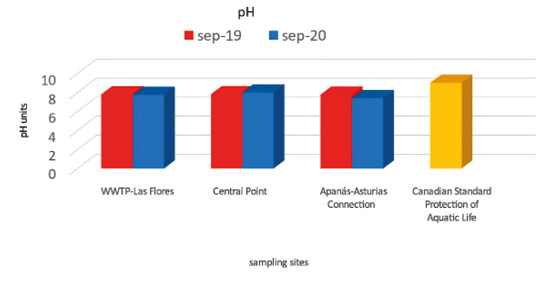
Figure 2. pH behavior in the Apanás-Asturias Reservoir in Sep-19 and Sep-20.
The pH in the three points studied is between the values established by Roldan (2008), for natural waters (6.0 and 9.0 pH units) and within the normal values for environmental protection according to the Canadian EQGs Standards that establish a pH between 6.5 and 9.0 pH units, for fresh waters. The waters of the Apanás-Asturias reservoir do not represent a threat to aquatic life because the fish support pH values between 5.0 and 9.5 units.(Custodio & Llamas, 2001)
3.3. Turbidity and True Color
The turbidity of the water in the Apanás-Asturias reservoir in the three sampled sites presented intervals between 7.15 UNT to 47.20 UNT in Sep-19 and 16.25 UNT to 48.50 UNT in Sept-20, with the highest value being found at the WWTP-Las Flores point in both and few sampling (Fig. 3). The results found in the PTAR-Las Flores Point in both and few sampling showed the influence of the contributions of wastewater from the WWTP of the city of Jinotega. Direct discharges to the water body by urban runoff can increase the ecosystem’s turbidity. (Gautier, 2003) On the other hand, the dragging of sediments by surface runoff and rivers to the reservoir produced by erosive processes in the basin, which are transported during the movement of water in the reservoir from the top to the bottom in the work of intakes mental turbidity at the PTAR-Las Flores Point. According to, the greater amount of dissolved particles and solids product of (Glasstone, 1979)erosion and resuspension of the beds by the fluvial activity of the ecosystem.
It is important to note that sediments increase turbidity in the reservoir water probably due to the presence of suspended matter such as clay, sand, finely divided organic matter, microscopic algae, and other microscopic organisms generated by deforestation in the basin that causes soil losses due to erosion. According to, the main (Ramírez & Viña, 1998)cause of turbidity is the erosive and extractive processes and its effect on aquatic ecosystems is manifested in the reduction of light penetration and with it, the impediment of photosynthesis, causing oxygen not to be released, which is necessary for aerobic organisms.
In this research, the color showed a behavior similar to turbidity, obtaining in the PTAR-Las Flores Point the highest values in both months sampled (Fig. 3). The color in the water of the reservoir is possibly due to suspended and dissolved particles that are transported by surface runoff from the basin to humic substances and leaves (yellowish-brown or brown color), phytoplankton (green, reddish, yellow-brown) and organic material (black). According to, (Mackenzie & Susan, 2005) color of the water is due to colored substances in suspension or dissolved in it: organic matter from the decomposition of plants, as well as from various organic products and metabolites commonly found in them (yellowish colors). It is important to note that the coloration of the water from yellowish to brown in the three points sampled could be due to the presence of iron and manganese minerals. The presence of Fe and Mn soluble salts in poorly oxygenated groundwater and surface water also produces a certain color in water. (APHA, 2012)
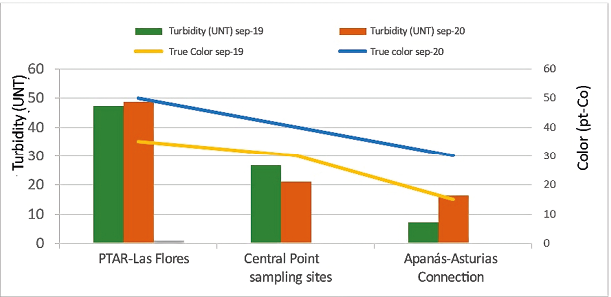
Figure 3. Turbidity behavior Vs True Color in the Apanás-Asturias Reservoir in Sep-19 and Sep-20.
3.4. Solid Suspense and Disco Secchi
The WWTP-Las Flores Point presented the highest amount of suspended solids in Sep-20 (Fig. 4). The distribution of suspended solids in Sep-20 reflects the transport of suspended particles by the flow of water from the upper to the lower part of the reservoir in the intake work and by the influence of wastewater from the WWTP-Las Flores of the city of Jinotega. Suspended particles, especially colloidal in size, such as clays, algae, iron, and manganese oxides and wastewater containing lignins, tannins, dyes, and other organic and inorganic chemicals cause color in water. (APHA, 2012)
On the other hand, it is important to mention the relationship between the depth of the Secchi disk and the solid suspense in this study. In both parameters, it is possible to observe the difference between the results obtained in the three sites and both épocas sampled; The WWTP-Las Flores site recorded the lowest depth measured with the Secchi disc in both months sampled and the highest concentration of suspended solids in Sep-20 (Fig. 4).
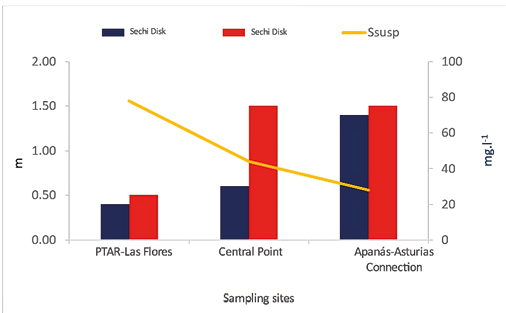
Figure 4. Behavior of transparency in theEbalse Apanas – Asturias in Sep-19 and Sep-20 and Suspended Solids in Sep-20.
According to the results obtained from the Secchi disc, the lowest water transparency in the Apanás-Asturias reservoir was obtained at the WWTP-Las Flores point in Sep-19 and Sep-20 with 0.50 m and 0.60 m depth respectively (Fig. 5). Thissituation is possibly due to turbidity caused by matter suspended in water, which is the opposite of clarity. According to, (Gholizadeh, Melesse, & Reddi, 2016)transparency and turbidity in water are directly related.
3.5. Conductivity and total dissolved solids
The results of EC in the water of the Apanás-Asturias reservoir varied between 105.70 μ s.cm-1 to 112.60 μ s.cm-1 in Sep-19 and 102.00 μ s.cm-1 to 117.20 μ s.cm-1 in Sep-20, with the highest value being found at the PTAR-Las Flores Point in both sampled periods (Fig. 5). Concerning total dissolved solids (STD), this study varied between 67.73 to 76.08 mg.l-1 in Sep-19 with the highest value at the Central Point and58.00 to 90.00 mg.l-1, in Sep-20 with the highest value being found at the PTAR-Las Flores Point.
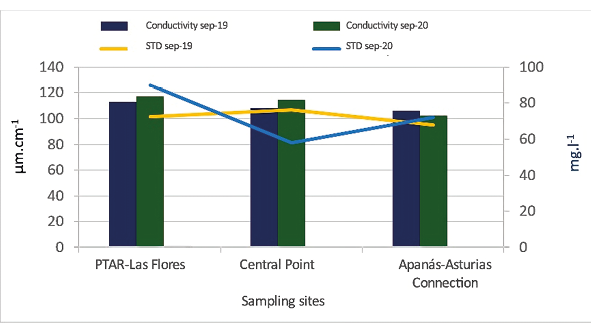
Figure 5. Values of electrical conductivity vs total dissolved solids in the Apanás-Asturias Reservoir in Sep-19 and Sep-20.
The STD values found in the reservoir were related to the electrical conductivity found in most of the sampled sites, except for Point Central which presented the highest value in Sep-19 with 76.08 mg.l-1 and the lowest value in Sep-20 with 58.00 mg.l-1 (Fig. 5). Conductivity is related to the total concentration of dissolved solids and major ions, and is very sensitive to variation of dissolved solids, especially mineral salts.(Custodio & Llamas, 2001)(Ramírez & Viña, 1998)
3.6. Dissolved oxygen
The concentrations of dissolved oxygen in the water of the Apanás-Asturias reservoir varied between 6.76 mg.l-1 to 8.49 mg.l-1 in Sep-19 and 5.56 mg.l-1 to 7.27 mg.l-1 in Sep-20, being in both sampling periods the highest value at the Central Point (Fig. 6).
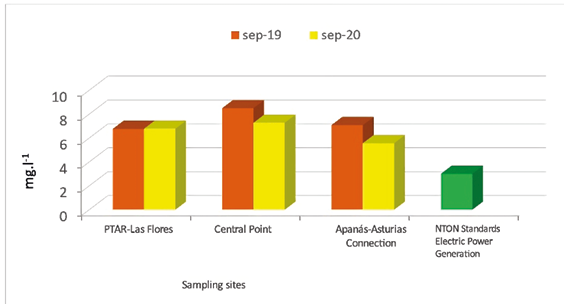
Figure 6. Dissolved oxygen behavior Values in the Apanás-Asturias Reservoir in Sep-19 and Sept-20.
The DO results had variability in the two sampling periods. The behavior of the DO in the WWTP-Las Flores Point could be due to the contribution of wastewater from the treatment plant of the city of Jinotega, while in the Apanás-Asturias Connection site in Sep-20 it could be due to the contribution of nutrients by surface runoff and tributaries from the basin. According to, in reservoirs the concentration of DO varies depending on the increase in biological productivity as a result of the entry of nutrients and organic matter, the pattern of thermal distribution, its trophic state, as well as its geographical location, morphometry, and meteorological conditions. (Likens, 1972)
The DO concentrations at the three points sampled in the Apanás-Asturias Reservoir are within the limit established by the Nicaraguan Technical Standard for the Classification of Water Resources (NTON, 2000) for waters intended for navigation and electricity generation (> 3.0 mg.l-1).
3.7. Nutrients
3.7.1. Nitrogen
The concentrations of Total Nitrogen (NT) in the three sites sampled in the Apanás-Asturias reservoir ranged from 0.325 mg.l-1 to 0.925 mg.l-1 in Sep-19 and 0.436 mg.l-1 to 0.750 mg.l-1 in Sep-20, with the highest value observed at the PTAR-Las Flores site in both sampling periods (Fig. 7).
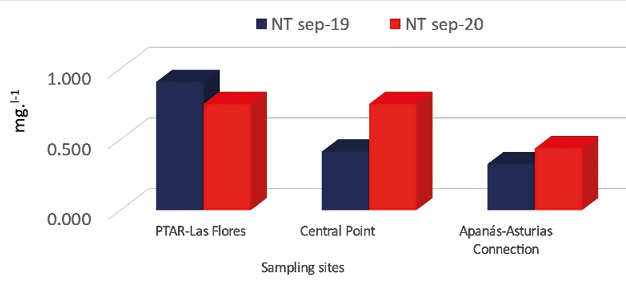
Figure 7. Total nitrogen distribution in the Apanás-Asturias Reservoir in Sep-19 and Sep-20.
NT concentrations increased at the sites located at the Central Point and the Apanás-Asturias Connection Point in Sept-2020, decreasing at the PTAR-Las Flores Point. This behavior of the NT in the study area and especially in the WWTP-Las Flores Point is possibly due to the influence of urban discharges from the city of Jinotega and runoff from deforested areas in the basin. Organic forms are present in the excreta of organisms and detritus; mainly as polypeptides and amino groups.(Lampert & Sommer, 2007)
3.7.2. Phosphorus
The concentrations of Total Phosphorus (FT) in the water of the Apanás-Asturias reservoir varied between 0.051 mg.l-1 to 0.144 mg.l-1 in Sep-19 and 0.040 mg.l-1 to 0.123 mg.l-1 in Sep-20, with the highest value being found at the PTAR-Las Flores Point in both sampled periods (Fig . 8).
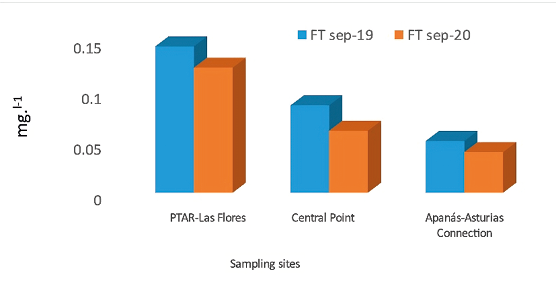
Figure 8. Distribution of Total Phosphorus in the Apanás-Asturias Reservoir in Sep-19 and Sep-20.
The PT found at the WWTP–Las Flores Point is possibly due to the influence of wastewater discharges from treatment plants in the city of Jinotega and sediments, which are transported by surface runoff and rivers from the basin. The main sources of phosphorus are the decomposition of primary producers in the water column and substrates, the decomposition of animal and plant remains, the dumping of domestic and industrial waste, the washing of fertilized soils, and the washing of apatite, vivianite, and phosphorite among others. (Wetzel, 1983)
3.7.3. Iron
Iron values showed large variations in this study; they ranged from 0.27 to 1.70 mg. l--1 in Sep-19 and from 1.18 to 2.15 mg.l-1 in Sep-21 (Fig. 9). Iron concentrations are higher in Sep-20, reflecting a deterioration of water quality in the reservoir; mainly in the PTAR-Las Flores Point.
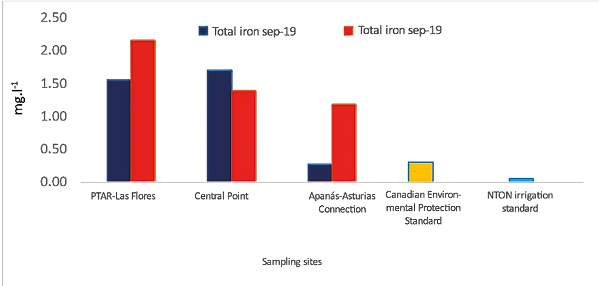
Figure 9. The behavior of iron in the Apanás-Asturias Reservoir in Sep-19 and Sep-20.
The iron found in all the sites sampled in the Apanás-Asturias reservoir in Sep-19 and Sep-20 could be by the dissolution of the rocks composed of iron-rich feldspars (Custodio & Llamas, 2001) that are characteristic of the geology of the study area, which is transported by runoff and tributaries to the Apanás-Asturias reservoir. The erosion of soils in the study area tends to increase the concentration of total iron in the water during the rainy season because they are attached to soil particles, in addition, iron precipitates when the water is oxygenated, forming Fe(OH)3and causes a reddish color that is commonly observed in rivers. (Gonzalez, 2004)
Fe concentrations at all sampled sites were above the maximum allowable value for Canadian Environmental Protection (0.3 mg.l-1) and above the NTON permitted value for irrigation (0.05 mg.l-1).
3.8. Chlorophyll a
The results obtained from Chlorophyll a in the Apanás – Asturias reservoir varied in Sep-19 between 7.10 μg.l-1 to 11.84 μg.l-1, obtaining the highest value in the WWTP-Las Flores Site, while Sep-20 they varied between 12.43 μg.l-1 to 15.39 μg.l-1, with the highest value observed at the Central Point (Fig. 10).
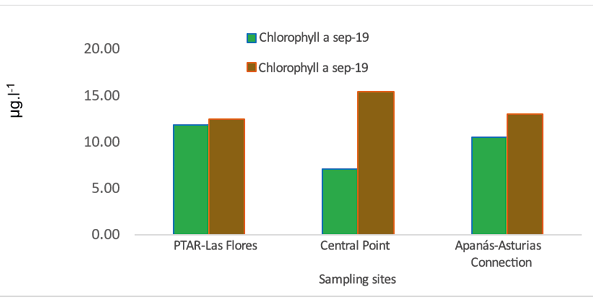
Figure 10. Distribution of chlorophyll a in the Apanás-Asturias Reservoir in Sep-19 and Sep-20.
It can be seen in Figure 13 that the results of Clorofila a were higher in Sep-20 when compared with those obtained in Sep-19 in the Apanás - Asturias Reservoir. It is important to mention that in the WWTP-Las Flores site the results of chlorophyll a were similar unlike the Central Point and Connection Apanás – Asturias that showed different values from Sep-19 to Sep-20. These values of Chlorophyll a obtained in this study are considered high and evidence of a process of eutrophication in the ecosystem, accelerated by anthropogenic activities present in the basin.
3.9. Trophic State
The trophic status was determined using the results obtained from the concentration of chlorophyll a, total phosphorus, and transparency of the water column applying the Carlson Index modified by Toledo in the three sites sampled in the Apanás – Asturias reservoir in Sep-19 and Sep-20 (Table 2).
|
Toledo |
Chlorophyll a |
FT |
DS (m) |
IEMT |
Chlorophyll a |
FT |
DS (m) |
IEMT |
|
Sampling sites |
sep-19 |
sep-20 |
||||||
|
WWTP-Las Flores |
64.38 |
62.17 |
66.82 |
64.46 |
64.87 |
60.60 |
63.60 |
63.02 |
|
Central Point |
59.25 |
57.02 |
60.97 |
59.08 |
67.01 |
53.58 |
47.75 |
56.11 |
|
Connection Apanás-Asturias |
63.18 |
51.79 |
48.75 |
54.57 |
65.34 |
49.36 |
47.75 |
54.15 |
Table 2. Results of the trophic status index of the water of the Apanás-Asturias reservoir in Sep-19 and Sep-20.
As evidenced in Table 3, the trophic status of the waters of the Apanás-Asturias reservoir at the WWTP-Las Flores and Punto Central sites is eutrophic in Sep-19 and Sep-20, while at the Apanás-Asturias Connection site the trophic state is Mesotrophic (Table 3).
|
Toledo |
IEMT |
Trophic State |
IEMT |
Trophic State |
|
Sampling sites |
sep-19 |
sep-20 |
||
|
WWTP-Las Flores |
64.46 |
Eutrophic |
63.02 |
Eutrophic |
|
Central Point |
59.08 |
Eutrophic |
56.11 |
Eutrophic |
|
Connection Apanás-Asturias |
54.57 |
Mesotrófico |
54.15 |
Mesotrófico |
Table 3. Results of the trophic status index of the water of the Apanás-Asturias reservoir in Sep-19 and Sep-20.
The results obtained with the Toledo index indicate that there is a certain degree of eutrophication in the WWTP-Las Flores and Punto Central sites, which must be taken into account to better manage water resources and waste from the basins involved in this study.
4. Conclusions
The surface waters of the Apanás – Asturias Reservoir are of the calcium bicarbonate type and do not present severe alterations in their physical and chemical composition, except for turbidity, true color, and iron. The site located in the Central part presented alterations in the concentrations of Fe in Sep-19 and total nitrogen in Sep-20, due to the influence of its location and economic activities that take place around the studied site. From the microbiological point of view, contamination of fecal origin was found in the site located in front of the Central Part of the reservoir in Sep-19 and Sep-20, which implies a deterioration of the quality of the water and limits its potential for domestic and recreational purposes. The trophic status of surface waters in the Apanás-Asturias reservoir is eutrophic as a function of the concentrations of Total Fósforo and Chlorophyll - at Sep-19 and Sep-20 and pieces of evidence problems ofeutrofización caused by anthropogenic activities in the basin.
THANKS
To the National Autonomous University of Nicaragua (UNAN-Managua), through the Vice Rectorate for Research for the support provided with the Funds for Research Projects (FPI) and to the Center for Research in Aquatic Resources of Nicaragua (CIRA/UNAN-Managua) for co-financing this research with identification number 41201804 and to the different public and private entities, which were an essential part in the development of this research. The participating entities were: RIKOLTO, GRUPO MASLAGO, and the National Electricity Company (ENEL).
Work cited
APHA. (2012). Standard Methods for the Examination of Water and Wastewater. Washington.
Casamor, J. (1992). Transport and sedimentation of suspended material in reservoirs: The Camarasa reservoir.
Castillo, E., Calderón, H., Delgado, V., Flores, Y., & Salvatierra, T. (2006). The situation of water resources in Nicaragua. Geological and Mining Bulletin, 127-146.
Custodio, E., & Llamas, M. (2001). Underground Hydrology. Volumes I and II. Barcelona, Spain: Omega, S. A.
Deborah, C. (1996). Water Quality Assessments. A guide to using Biota, Sediments, and Water in Environmental Monitoring. London.
ENEL. (2013). Water balance, flow, erosion, sedimentation, and bathymetry of the Apanás - Asturias reservoir.
Garcia, C. (2016). Guajaro Reservoir. Environmental Diagnosis and Rehabilitation Strategies.
Gautier, V. (2003). Impact of raw water turbidity fluctuations on drinking water quality in distribution systems. Journal of Environmental Engineering and Science, 281-291.
Gholizadeh, M., Melesse , A., & Reddi, L. (2016). A Comprehensive Review on Water Quality Parameters Estimation Using Remote Sensing Techniques. Sensors, 16.
Glasstone, S. (1979). Treatise on Physical Chemistry. Madrid. Spain.
González, R. (2004). Study on water quality and danger of contamination of public supply wells, Rio Viejo and Grande de Matagalpa in the Sebaco Valley. Managua.
Lampert, W., & Sommer, U. (2007). Limnoecology. In: Special Feature of aquatic habitats. New York: Segunda edición. Oxford University Press Inc.
Likens, G. (1972). Eutrophication and aquatic ecosystems. Limnol. Oceanog, 3-13.
Mackenzie, D., & Susan, M. (2005). Engineering and Environmental Sciences.
Ramírez, R., & Viña, G. (1998). Colombian Limnology contributes to its knowledge and analysis of statistics. Bogota. Colombia.
Sriwongsitanon, N., Surakit, K., & Thianpopirug, S. (2011). Influence of atmospheric correction and number of sampling points on the accuracy of water clarity assessment using remote sensing application. Journal of Hydrology, 203-220.
Wetzel, R. (1983). Limnology. San Diego: Academic Press.
Footnotes
a. Evaluation of water quality through physical-chemical variables and eutrophication indicators in the Hydroelectric Reservoir Apanás -Asturias, (RAMSAR No. 1137), Jinotega. East project with the identification number 41201804 Was co-financing by Investi's Project Funds(FPI) of the UNAN-Managua and the Center for Research in Aquatic Resources of Nicaragua (CIRA/UNAN-Managua) and different public and private entities, which were an essential part in the development of this research (ENEL, MASLAGO GROUP, and REKOLTO). Developed in the period 2018 – 2021 under the research line: Quality of marine – coastal resources. Yader Knight.